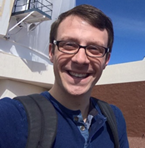|
|
|
Shampoo
for SHAMU Astronomy and
Astrobiology grad student Brett Morris’ research rotation let him swap his
telescope for a microscope as he learned about techniques for detecting life
on the Solar System’s icy worlds. By Brett Morris Graduate Student, Astronomy &
Astrobiology
In my research rotation project, I was privileged
to join a team of interdisciplinary experts on microbial motility and
holographic microscopy who seek to test the hypothesis: “is microbial
motility an unambiguous biosignature of extant life?” We know that
organisms on Earth have innumerable reasons to move; for example, organisms
move towards nutrients, away from toxins, towards heat, towards light.
Perhaps life on worlds like Enceladus would evolve motility as well. One
advantage of searching for microbial motility, rather than searching for ATP
or DNA, is that the motility hypothesis is agnostic about the chemistry of
the organisms that are moving, so long as the organisms move. We are testing this hypothesis by studying motile
terrestrial microbes with SHAMU – or the “Submersible Holographic
Astrobiology Microscope with Ultraresolution” led by PI Jay Nadeau,
(Portland State University). SHAMU is a digital holographic microscope (DHM)
with ~1 micron resolution. The hardware required is compact, requires
comparatively little energy and no moving parts, which makes it a good
candidate for future space exploration missions. Digital holographic microscopes use
interferometry to measure perturbations imparted on the phase and amplitude
of a laser beam by small specimens – on scales similar to the wavelength of
the laser (300 nm). The holograms recorded by the DHM encode the full phase
and amplitude of the light at every position in the fluid sample chamber,
allowing us to locate the 3D positions of specimens in each hologram.
Time-series holography allows us to measure the full 3D
velocities of the specimens as they move with bulk flow in the fluid, and as
they swim. Unambiguously detecting this difference between bulk
flow and swimming – algorithmically, and with minimal human intervention – is
the near-term goal of the SHAMU project. One of
the primary obstacles to achieving this goal is a computational bottleneck.
Each hologram recorded by the microscope must be processed to recover the
phase and amplitude information – this process is called hologram
reconstruction. When I began working with the SHAMU team, all reconstructions
were completed with proprietary, “black-box” software (Koala Acquisition
& Analysis by Lyncée Tec), for which
the group had a limited number of licenses. It could take several days for
the software to finish reconstructions for an hour’s worth of microscope
observations. My
contribution to the SHAMU project was to create the first open source
numerical holographic reconstruction toolkit in Python, which could be used
alongside or in place of the proprietary software. There are several
advantages to creating our own software pipeline: (1) we know what the
software is doing at each step in the reconstruction process, (2) we can
tweak the reconstruction algorithm to suit our motility observations, (3) the
free software is platform independent and can be used on as many machines as
you have access to (no license necessary), (4) despite being written in
Python, which is generally thought of as a “slow” language, our pipeline is
more efficient than the alternative package with limited licenses, because
you can run our free software with many reconstruction jobs in parallel,
greatly reducing the wall clock time for a given reconstruction. Many of
the tasks necessary for numerical reconstruction of digital holograms are
performed manually by microscope users. For example, the user might be
required to create a real-image mask in Fourier-space, and to select
background regions of a reconstructed image, which are used to train
aberration correction routines. These steps are redundant if the holographic
microscope configuration that doesn't change significantly from one
observation to the next, and if the area of the image occupied by specimens
is typically small compared to the background –as is the case when working
with unresolved specimens. The software I developed takes advantage of these
opportunities to automate the reconstruction and aberration correction
processes. The software
package, dubbed “shampoo”, has been adopted by the SHAMU group, and I
continue to lead code development and maintenance in collaboration with J.
Kent Wallace and Santos Fregoso (NASA
JPL). We are in the early stages of writing up a paper for submission to the
journal Applied Optics on the many design decisions that went into our
custom-tailored reconstruction algorithm. The source code is freely available
on GitHub* In this
project I learned so much that it’s hard to summarize concisely, thanks to
the guidance of my advisor Professor Jody Deming, her graduate student Max
Showalter, and the rest of the SHAMU team. I learned about the types of
microbial motility, I learned how digital holographic microscopy works, I
wrote a numerical reconstruction algorithm from scratch, I learned how to
collaborate in a large research group with experts across many
non-overlapping disciplines, and perhaps most importantly, I learned how to
better communicate my work with the others in the group. It has been one of the
greatest privileges of my graduate career to work with this group, and I
thank the UW Astrobiology Program for its support in making my research
rotation appointment possible. *
Source code: https://github.com/bmorris3/shampoo |
|
THIS E-NEWSLETTER WAS SENT BY:
|


